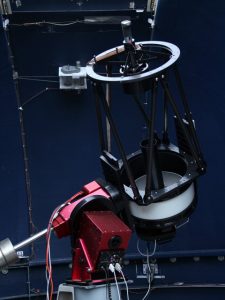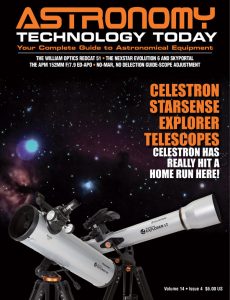New Mexico Skies are helping a new accreditation program which will train high school teachers to use amateur telescope technology for classroom projects and to train students in the telescope’s use.
The new program is made possible in large part through a donation by Christian Pérez and Mike and Lynn Rice of New Mexico Skies to provide access to a 16” RC Optical Systems telescope set up for astroimaging. New Mexico Skies hosts more than 50 robotic telescope systems operating at their Northern Hemisphere facility located outside of Cloudcroft, New Mexico and its Southern Hemisphere site located in the outback desert of South Australia.
 The program is part of a new program at the Montana Learning Center which has partnered with the Montana State University National Teacher Enhancement Network to offer a free course for high school teachers to get certified in the use of the telescope and learn how to integrate it into their classroom. The training is provided through a 30-hour online course which will count toward 60 hours of required instruction renewal units teachers are required to take every five years.
The program is part of a new program at the Montana Learning Center which has partnered with the Montana State University National Teacher Enhancement Network to offer a free course for high school teachers to get certified in the use of the telescope and learn how to integrate it into their classroom. The training is provided through a 30-hour online course which will count toward 60 hours of required instruction renewal units teachers are required to take every five years.
The online course is for teachers who want to have their students implement classroom projects utilizing a robotic observatory. The course focuses on the methods used in performing astrophotography and photometric research, with an emphasis on how these can be turned into projects used by students in the classroom. Teachers develop and tailor their own curriculum using the robotic observatory. Upon completion of the course the teachers will be able to continue to use the robotic telescope for student projects.
“It’s exciting for us at the Montana Learning Center to partner with Montana State University’s National Teacher Enhancement Network on this opportunity,” said Ryan Hannahoe, executive director of the Montana Learning Center. “The Spring 2020 course serves as the groundwork for a proposed three-credit graduate course for teachers. The remote telescope is a key part of our astronomy program.”
The course instructor is Peter Detterline, who has a wide and varied background that is well suited for teaching the new course as he has worked with robotic telescopes in the classroom for two decades. As Observatory Director for the Mars Society, he operates two telescopes, a solar observatory and a robotic observatory. He also teaches a hybrid course on astronomy for Montgomery County Community College and two online courses for Moravian College in Pennsylvania.. He retired after 35 years as the Planetarium Director for the Boyertown Area School District where he gave programs to over half a million people of all age groups. He also developed the curriculum for the Montana Learning Center’s Explore the Universe Camp. In addition he has done professional research on eclipsing binary stars, and currently works with the American Association of Variable Star Observers on adding to their variable star database. And he has vast knowledge on the telescope time donated by New Mexico Skies.
“For this first class, the projects will be driven by astrophotography. Projects depend on what teachers’ needs are in the classroom,” said Detterline, “but I’ve successfully used student images to teach stellar evolution, galaxy morphology, asteroid velocity, the orbits of the moons of Uranus and discovery programs looking for supernovae, asteroids or comets. There are many possibilities.”
He continued, “At the end of the first class, we will have a project database set up online where teachers can get ideas and post their own projects and experiments to share with others. For later classes, we will be getting photometric filters so students and teachers can actually do real, publishable research such as variable star measurements.”
“If a student or teacher wants to learn about astronomy, in most cases they have only a textbook to access,” Hannahoe, of the Montana Learning Center, said. “Very rarely do students and teachers have access to telescopes and even more rarely telescopes located at world-renown observatories. We aim to provide that resource to them so that they can have access to research-grade equipment.”
He continued, “In 2001, I was able to help put the first fully remote controllable telescope on the Internet for students and teachers to use,” Hannahoe said. “It is a real pleasure to come full circle since then and provide students and teachers with a similar opportunity that I received as a child. For me, it was life changing and sparked a lifelong passion for astronomy.”
 And to make it easier for you to get the most extensive news, articles and reviews that are only available in the magazine pages of Astronomy Technology Today, we are offering a 1 year subscription for only $6! Or, for an even better deal, we are offering 2 years for only $9. Click here to get these deals which only will be available for a very limited time. You can also check out a free sample issue here.
And to make it easier for you to get the most extensive news, articles and reviews that are only available in the magazine pages of Astronomy Technology Today, we are offering a 1 year subscription for only $6! Or, for an even better deal, we are offering 2 years for only $9. Click here to get these deals which only will be available for a very limited time. You can also check out a free sample issue here.

